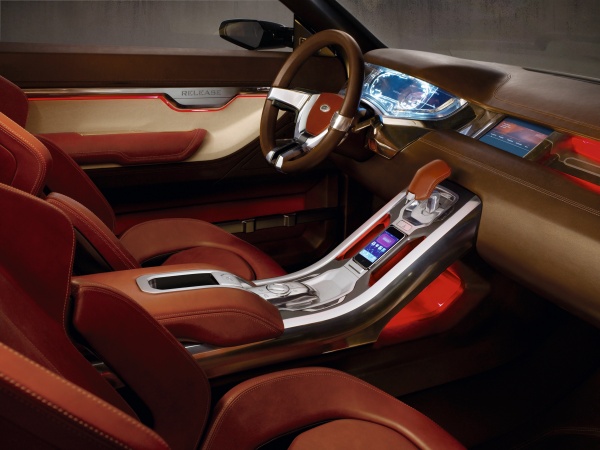The Range Rover Evoque is a compact SUV from Land Rover which went into production in July 2011. The vehicle will be available in three-door and five-door body styles, and with front-wheel only or four-wheel drive. The car was announced on 1 July 2010, and it designed to address the requirement for reduced CO2 emissions. A near production concept was unveiled at the North American International Auto Show as the Land Rover LRX in January 2008.
The car was launched as two distinct models: the five-door Evoque and the three-door Evoque Coupé. Each model is available in three trim levels - Pure, Prestige and Dynamic.
The Land Rover LRX concept vehicle was the most compact Land Rover to date. Its size complemented a wide array of efficiency improving technologies in the form of Land Rover's e_Terrain technologies. These included biofuel compatibility, lightweight construction materials and technologies such as the removable carbon composite roof panels, regenerative brakes, a stop-start system, and the ERAD (electric rear axle drive) parallel hybrid powertrain system. ERAD encompasses the incorporation of an electric motor into the rear axle of the vehicle. It would propel the LRX to speeds of up to 20 mph (32 km/h) before the engine was started by an integrated starter generator as part of the stop-start system. ERAD was designed to reduce CO2 emissions by an average of 20 percent under the NEDC test cycle and was expected to offer another 10 percent reduction in extra-urban driving situations. The system was designed to also optimise the off-road ability of the vehicle. Land Rover aimed to achieve 120 g/km CO2 emissions and fuel economy of 60 mpg-imp (4.7 L/100 km; 50 mpg-US) on the European combined cycle with an efficient 2.2-litre turbodiesel engine. The engine would become the only four-cylinder vehicle in the Range Rover lineup.
The LRX also boasted the latest incarnation of Land Rover's acclaimed Terrain Response system offering a range of new and existing modes. These included general driving; grass/gravel/snow; sand; and new to the LRX are sports and eco modes.
Typical Land Rover design traits designed to improve off-road performance and practicality included the command driving position, hill descent control and good approach and departure angles. A Land Rover first was the air intake being integrated into the roof to offer exceptional wading capabilities.

.jpg?m=1287020652\x26imgrefurl\x3dhttp://www.7autoblog.info/index.php/photos/2159\x26usg\x3d__nmL1clngX28COl395D67RPZqEmg\x3d\x26h\x3d648\x26w\x3d973\x26sz\x3d48\x26hl\x3den\x26start\x3d10\x26zoom\x3d1\x26itbs\x3d1)




No comments:
Post a Comment